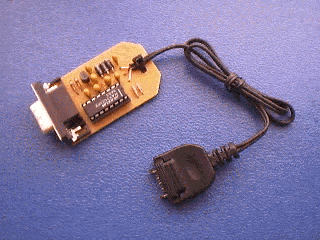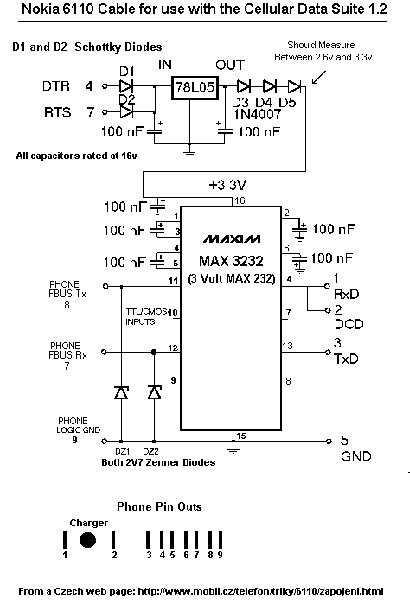


Following is a description on how to make a compatible Nokia Data Cable yourself.
You can also buy it assembled and ready to work for 50 US$ (+S/H). Click on the image
below to use our secure order form.
If you find that it does not make much sense to you DO NOT ATTEMPT TO BUILD THE CABLE, it might save the life of your phone!
How to make the cable
The cable consists of four parts, the RS232 (DB9 Serial) connector, the
3.3volt power supply, the MAX 3232 IC and the phone connector.
The RS232 end supplies 12v via pins 4 and 7, through 2 (DI, D2) Schottky barrier diodes to a low power (500ma) 5 volt regulator, the 5v output goes through 3 diodes (D3, D4, D5), each of these diodes drops the voltage by 0.6v, so that about 3.3v is delivered to the MAX3232.
The MAX3232 is a 3volt version of the popular MAX232 TTL to RS232 converter IC, that is used by a number of manufacturers for their interface cables. The 2V7 Zenner diodes hold the TX and RX date lines to the phone at a safe maximum limit of 2.7volts. Note that the capacitor on pin 6 of the IC has it's +ve lead to ground.
The hardest part to get hold of might be the phone connector.
Notes In practice the diodes D1 and D2 can be general purpose 1N4148 diodes, and D3, D4 and D5 can be 1N4001 diodes. The circuit should be built as shown. Be sure to check all solder joints and the orientation of components.The above information should be more than enough for the electronic hobbyist to
construct a working cable.

Download the PCB and complete instructions in Word format (600 Kb)
You can also buy it assembled and ready to work for 50 US$ (+S/H). Click on the image
below to use our secure order form.
![]()
This page was last updated on 24-03-2000.
All trademarks and logos are copyright of their respective owners.
(C) 1998-1999-2000 Stelios Koroneos